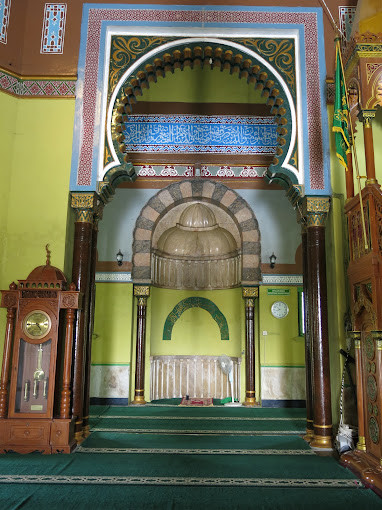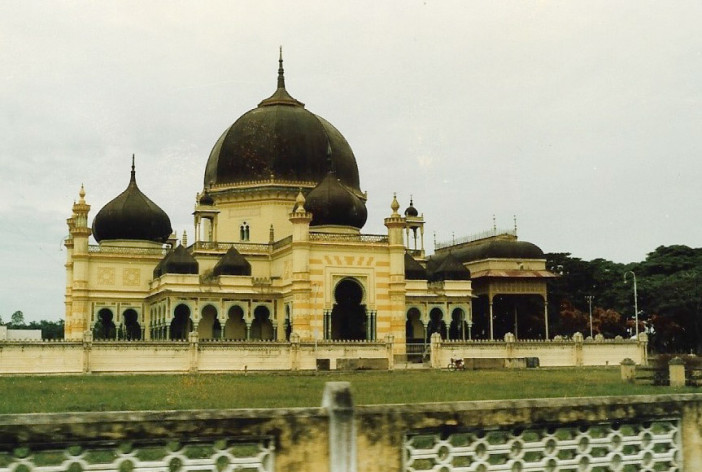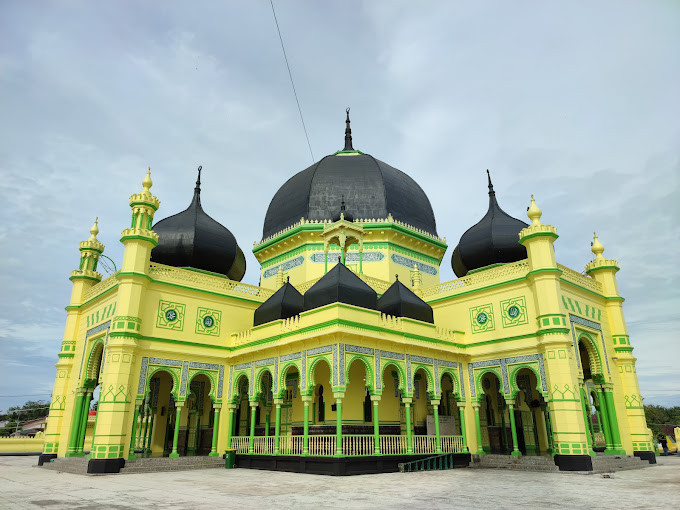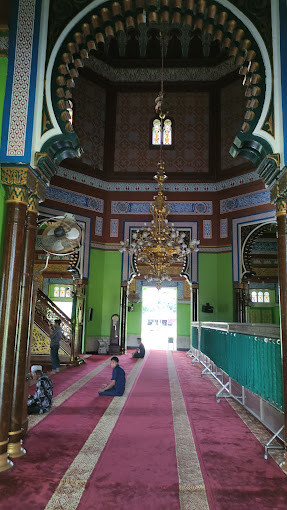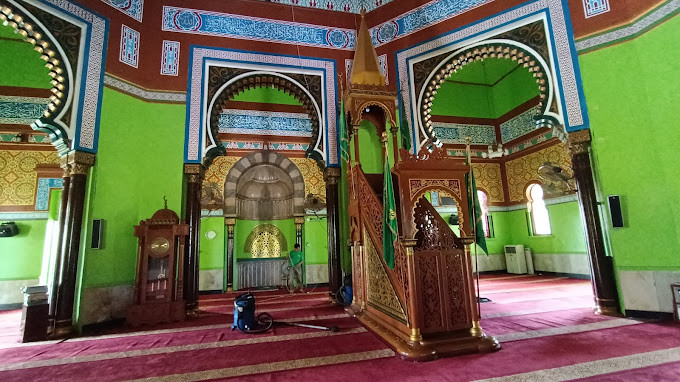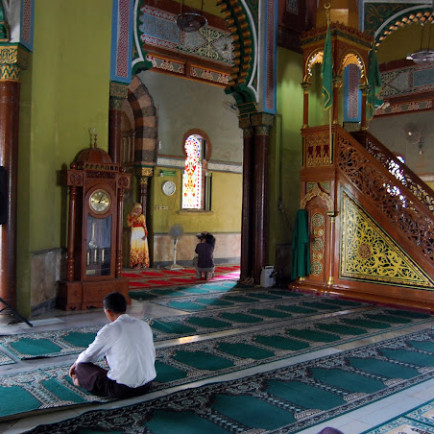Azizi Mosque
History
The Azizi Mosque stands on an area of 18,000 square meters, the Azizi Mosque was built on the advice of Sheikh Abdul Wahab Babussalam during the reign of Sultan Musa al-Muazzamsyah. Construction began in 1320 H (1899M) or at least 149 years since Langkat was officially established as a Sultanate, but Sultan Musa died before the construction of the mosque was completed. The construction was continued by his son, who had the title Sultan Abdul Aziz Djalil Rachmat Syah (1897-1927) the 7th Sultan of Langkat.
The design of the mosque was handled by a German architect, many of whose workers were of Chinese ethnicity and the Langkat community itself. Meanwhile, building materials were imported from Penang, Malaysia and Singapore by ship to Tanjungpura. At that time the Batang Serangan river was still functioning well and ships with a tonnage of 600 tons could sail it.
The Azizi Mosque was inaugurated by Sultan Abdul Aziz Djalil Rachmat Syah to coincide with the commemoration of the Prophet Muhammad's birthday and the commemoration of the change of the Kingdom into the Langkat sultanate on 12 Rabiul Awal 1320H ( June 13 , 1902 AD) spending around 200,000 Ringgit, and named the Azizi mosque according to the name Sultan Abdul Aziz Djalil Rachmat Syah .
Urban and Architectural
The Azizi Mosque has a mixed Middle Eastern and Indian style with many domes with a capacity of around 2000 worshipers at once. The main building is 25 × 25 m in size and ± 30 m in height. The three sides of the mosque are equipped with respective porches on the east, north and south sides, each of these porches is directly connected to the corridors on three sides of the mosque and leads directly to the entrance. The pillars of the porch that stand on the left and right are octagonal, similar to small towers, with flower buds at the ends. The porch and terrace of the mosque are equipped with Middle Eastern pillars and arches decorated with calligraphy, geometric shapes and floral carvings.
The main room of the mosque has a rectangular wall measuring 20 × 20 m. The floor of the main room was previously covered with ceramic but has now been replaced with marble, the rest of the tiled floor can still be seen in the middle of the main room floor. The outer wall of the main room is decorated with Qur'anic calligraphy, geometric and floral ornaments. The inner wall of the main room is full of ornaments, the lower side is covered with marble, while the upper side is decorated with Al-Qur'an calligraphy, geometric and floral shapes. The Mihrab and minbar of the Azizi mosque are made of marble.
The minaret is located in the northeast of the mosque with a height of about 60 meters. The bottom of the tower is equipped with a door. The second part is decorated with an arched window on each side. The roof is in the shape of a dome with the moon at the top. Overall, the architecture of the Azizi mosque has several similarities with the Al Mashun grand mosque and the Al Osmani mosque in Medan, especially in the distinctive dome design.
Description
The Azizi Mosque is a mosque inherited from the Langkat Sultanate in Tanjung Pura Village, Tanjung Pura District , Langkat Regency , North Sumatra Province . During the Langkat Sultanate, this mosque was used as a court and palace mosque. The mosque building is located on the edge of the main road and is 500 meters from the former palace of the Sultan of Deli and the Pancasila Building which was used as the court of the Sultanate of Langkat in the past. The southern part of the mosque is the location of the graves of the Sultan of Deli and his family. To the north, west and east it is bordered by residential houses. The building area of the Azizi Mosque is 3,000 square meters. The Azizi Mosque has two 1 meter high iron fences that enclose the entire courtyard of the mosque and enclose the courtyard of the mosque. On the north side of the first fence there are two doors that lead to the mosque building via a large road that extends to the south side in front of the mosque and to the west side. In this courtyard stands a mosque and minaret, the tomb of the Langkat royal family, and the tomb of Tengku Amir Hamza . The graves of the sultan and his family are inside the second fence, while the other tombs are outside.
This mosque is located on the edge of the Sumatra causeway that connects Medan to Banda Aceh. It was built by Sultan Langkat Haji Musa in 1899, was completed and inaugurated by his son, Sultan Abdul Aziz Djalil Rachmat Syah on June 13, 1902. The beauty of the Azizi Mosque was then used as a reference for the construction of the Zahir Mosque in Kedah , Malaysia , so that the two mosques have similarities one with another.
Details
الموقع
Jl. Masjid No.1, Pekan Tj. Pura, Kec. Tj. Pura, Kabupaten Langkat, Sumatera Utara 20853, Indonesia
عدد المصليين
2000
المالك / المتبرع
Indonesian Mosque Council
المعماري
تاريخ البناء
1899
Area
3500
الرسومات المعمارية
الخريطة
History
The Azizi Mosque stands on an area of 18,000 square meters, the Azizi Mosque was built on the advice of Sheikh Abdul Wahab Babussalam during the reign of Sultan Musa al-Muazzamsyah. Construction began in 1320 H (1899M) or at least 149 years since Langkat was officially established as a Sultanate, but Sultan Musa died before the construction of the mosque was completed. The construction was continued by his son, who had the title Sultan Abdul Aziz Djalil Rachmat Syah (1897-1927) the 7th Sultan of Langkat.
The design of the mosque was handled by a German architect, many of whose workers were of Chinese ethnicity and the Langkat community itself. Meanwhile, building materials were imported from Penang, Malaysia and Singapore by ship to Tanjungpura. At that time the Batang Serangan river was still functioning well and ships with a tonnage of 600 tons could sail it.
The Azizi Mosque was inaugurated by Sultan Abdul Aziz Djalil Rachmat Syah to coincide with the commemoration of the Prophet Muhammad's birthday and the commemoration of the change of the Kingdom into the Langkat sultanate on 12 Rabiul Awal 1320H ( June 13 , 1902 AD) spending around 200,000 Ringgit, and named the Azizi mosque according to the name Sultan Abdul Aziz Djalil Rachmat Syah .
Urban and Architectural
The Azizi Mosque has a mixed Middle Eastern and Indian style with many domes with a capacity of around 2000 worshipers at once. The main building is 25 × 25 m in size and ± 30 m in height. The three sides of the mosque are equipped with respective porches on the east, north and south sides, each of these porches is directly connected to the corridors on three sides of the mosque and leads directly to the entrance. The pillars of the porch that stand on the left and right are octagonal, similar to small towers, with flower buds at the ends. The porch and terrace of the mosque are equipped with Middle Eastern pillars and arches decorated with calligraphy, geometric shapes and floral carvings.
The main room of the mosque has a rectangular wall measuring 20 × 20 m. The floor of the main room was previously covered with ceramic but has now been replaced with marble, the rest of the tiled floor can still be seen in the middle of the main room floor. The outer wall of the main room is decorated with Qur'anic calligraphy, geometric and floral ornaments. The inner wall of the main room is full of ornaments, the lower side is covered with marble, while the upper side is decorated with Al-Qur'an calligraphy, geometric and floral shapes. The Mihrab and minbar of the Azizi mosque are made of marble.
The minaret is located in the northeast of the mosque with a height of about 60 meters. The bottom of the tower is equipped with a door. The second part is decorated with an arched window on each side. The roof is in the shape of a dome with the moon at the top. Overall, the architecture of the Azizi mosque has several similarities with the Al Mashun grand mosque and the Al Osmani mosque in Medan, especially in the distinctive dome design.
Description
The Azizi Mosque is a mosque inherited from the Langkat Sultanate in Tanjung Pura Village, Tanjung Pura District , Langkat Regency , North Sumatra Province . During the Langkat Sultanate, this mosque was used as a court and palace mosque. The mosque building is located on the edge of the main road and is 500 meters from the former palace of the Sultan of Deli and the Pancasila Building which was used as the court of the Sultanate of Langkat in the past. The southern part of the mosque is the location of the graves of the Sultan of Deli and his family. To the north, west and east it is bordered by residential houses. The building area of the Azizi Mosque is 3,000 square meters. The Azizi Mosque has two 1 meter high iron fences that enclose the entire courtyard of the mosque and enclose the courtyard of the mosque. On the north side of the first fence there are two doors that lead to the mosque building via a large road that extends to the south side in front of the mosque and to the west side. In this courtyard stands a mosque and minaret, the tomb of the Langkat royal family, and the tomb of Tengku Amir Hamza . The graves of the sultan and his family are inside the second fence, while the other tombs are outside.
This mosque is located on the edge of the Sumatra causeway that connects Medan to Banda Aceh. It was built by Sultan Langkat Haji Musa in 1899, was completed and inaugurated by his son, Sultan Abdul Aziz Djalil Rachmat Syah on June 13, 1902. The beauty of the Azizi Mosque was then used as a reference for the construction of the Zahir Mosque in Kedah , Malaysia , so that the two mosques have similarities one with another.


